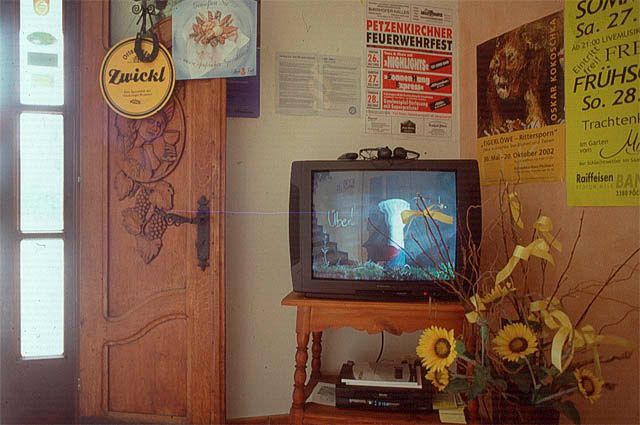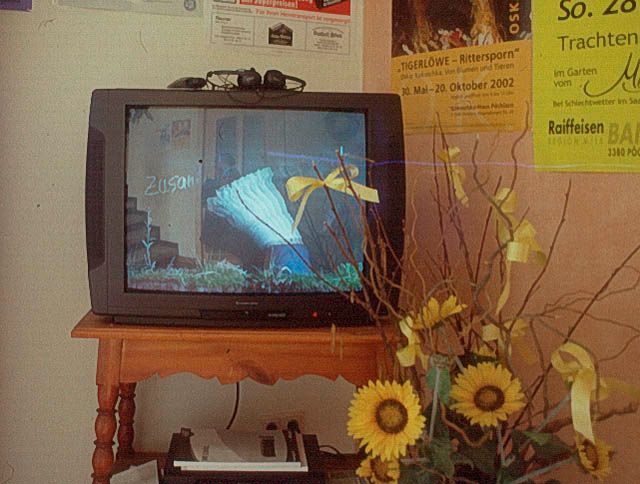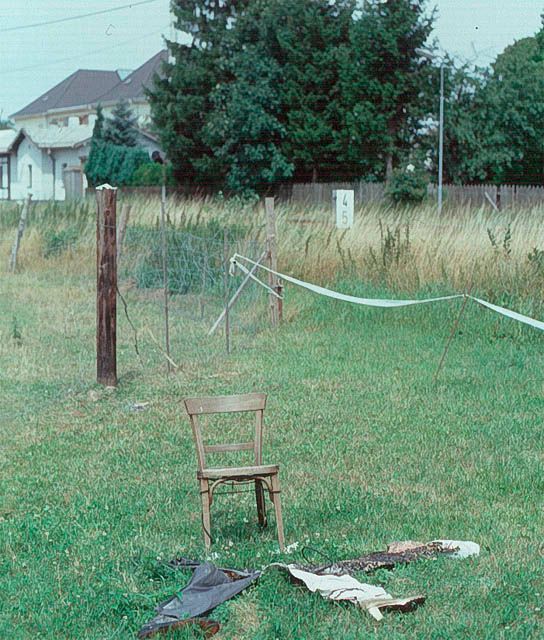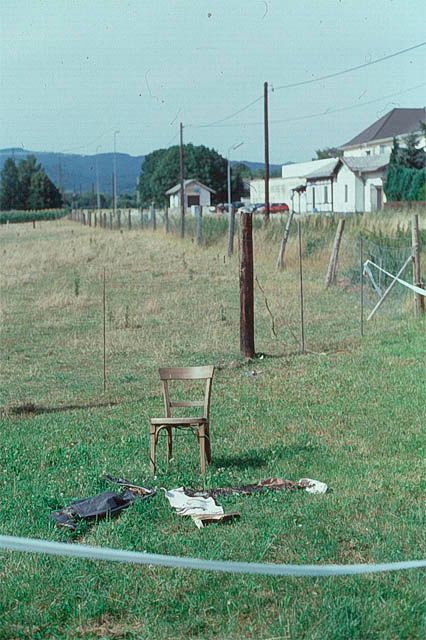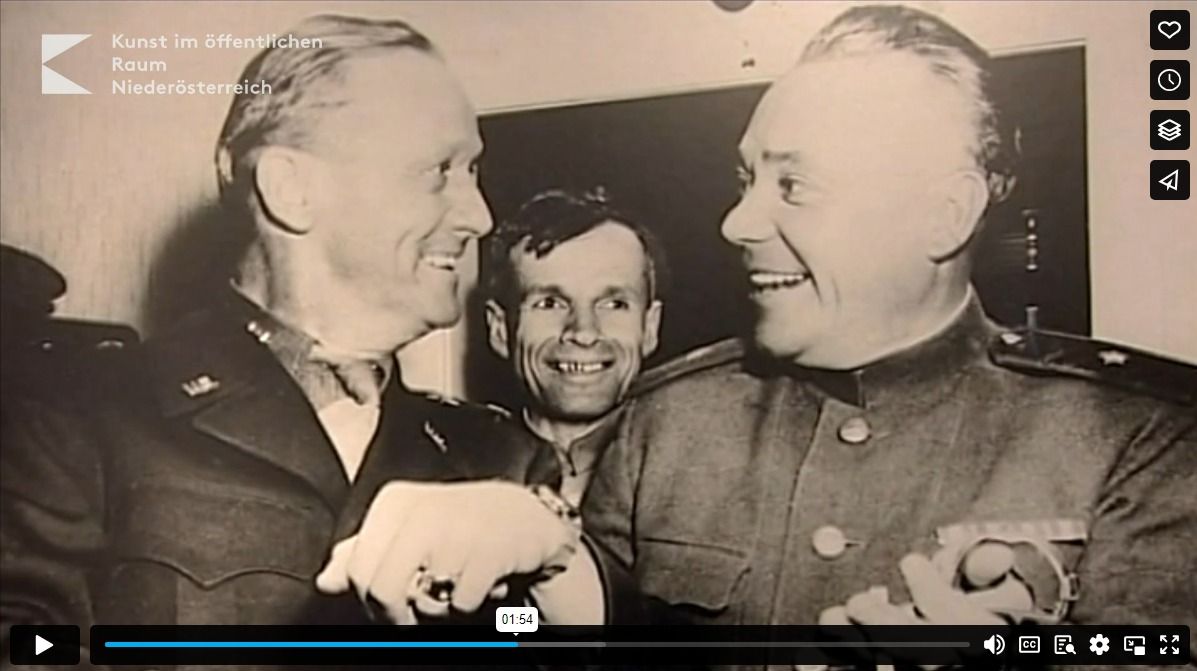Erlauf Remembers ... I
BackArtists
- With
Information
The 1200 inhabitants of the Erlauf in the district of Melk owe the knowledge of the village's participation in world history to an émigré who had to flee to the USA in 1938 because of racism. Almost unnoticed by the local residents, this was the site of the historic handshake between an American general and a Soviet general when Nazi Germany capitulated on 8 May 1945. The exhibition 'Erlauf erinnert sich ... (2) – Monumente, Gegenmonumente und Nation' (Erlauf Remembers... 2 – Monuments, counter-monuments and Nation) related to the two existing monuments (by Jenny Holzer and by Oleg Komov), the town itself, the Second World War and the Holocaust.
Contributors
- Kuration
Contributions
Alice Creischer
"Feindsliebchen" (The Enemy-Love)
Alice Creischer took the concrete historic situation, the encounter between the two generals, as the basis for her 18 minute video. in "Feindsliebchen" (The Enemy-Love) Creischer describes the situation of a symbolic trench war, where the strength of the two enemy factions is never equal. This inequality also applies to concrete present day power structures. The video was shown in the foyer of a pub (the Moststadl Gasthaus) in Erlauf. The installation at the railway crossing consisted of props from the video. The chair "is the seat of those who lurk, and the trouser legs (one of brocade, a silk morning coat tail and a sailor suit leg) denote the subject under observation". A sailor's song sung in the video when the two warring parties met was printed on an accompanying flyer (totally unsuitable for the region).
Sanja Iveković
"Lady Rosa von Luxembourg"
"Lady Rosa von Luxembourg", Sanja Ivekovic'svisibly pregnant unknown heroine is based on the "Gëlle Fra" (Golden Woman), the Luxembourg national figure. Ivekovic uses the position opposite the memorial by Oleg Komov to allude to the role of the young girl standing between its two generals. Komov had originally planned his memorial with a woman's figure standing in the place of the child as the uniting element, but this was rejected following opposition from the women of Erlauf. Ivekovic's 'Lady Rosa' stands is a feminist memorial that stands for the humiliation, the suffering and the pain that many women undergo through rapings in wartime and civilian life.
Werner Kaligofsky
without title
Werner Kaligofsky had streets in Erlauf temporarily renamed as memorials. His project is the result of oral research carried out in situ on the subject of the Holocaust and Resistance, as well as looking through old files. The project is about collective remembering again: Neudorferstrasse was renamed 'Familie Brod Strasse' and Molkereistrasse was renamed 'Familie Weiner Strasse'. In doing this Kaligofsky was commemorating the Jewish families from the community which were wiped out. In the course of his research in the Austrian Resistance document centre Kaligofsky also ran into a significant former resident in the anti-fascist resistance: the work of a communist mayor of Erlauf, Josef Munk, is on record. His name is a symbol for reflecting on the role of the resistance in Erlauf. Until the end of the exhibition the central square, Marktplatz, was renamed 'Josef-Munk-Platz'
Dorit Margreiter
"Reichsautobahn"
Ein "horizontales" Denkmal stand im Zentrum der Arbeit von Dorit Margreiter. Die A "horizontal" monument was at the centre of the project by Dorit Margreiter. The site on the Autobahn was the starting point for her research. A stretch of the foundations of the old Reichsautobahn have survived in Erlauf. Dorit Margreiter found interesting source material in the film 'Reichsautobahn' (1986) by Hartmut Bitomsky, where this monument of modernism is raised to the status of a work of art. "Bitomsky showed the peculiarities in the flood of images surrounding the construction work, the quality of which was more mythical than functional". Originally planned as a job creation scheme in the Third Reich, praised as a grandiose invention for architecture (civil engineering) and often affirmatively referred to as "a positive Nazi achievement", Margreiter exhibits the Autobahn as an object of cultural signifance.
Roman Ondák
"Das dritte Denkmal"
Roman Ondák from Bratislava had himself inscribed conceptually into the community, and created a silent anti-monument to the two permanent monuments. Ondák's second project alluded to the history of Erlauf: significant documents were reproduced in the history of the area with local kindergarten-goers and schoolchildren. So playfully having integrated the youngest local residents – as the community's future representatives. Posters with the same subject matter were subtly distributed around the whole community.
Harutyun Simonyan
"Uterus"
In the waiting room of Erlauf station Harutyun Simonyan from Yerivan (Armenia) focused on a monument with a different significance, the anti-monument: the retreat of the subject. In the video 'Uterus' the artist imaged being back in the foetus stage, at the same time bringing the exterior of the station into the interior space of the waiting room per video camera.
